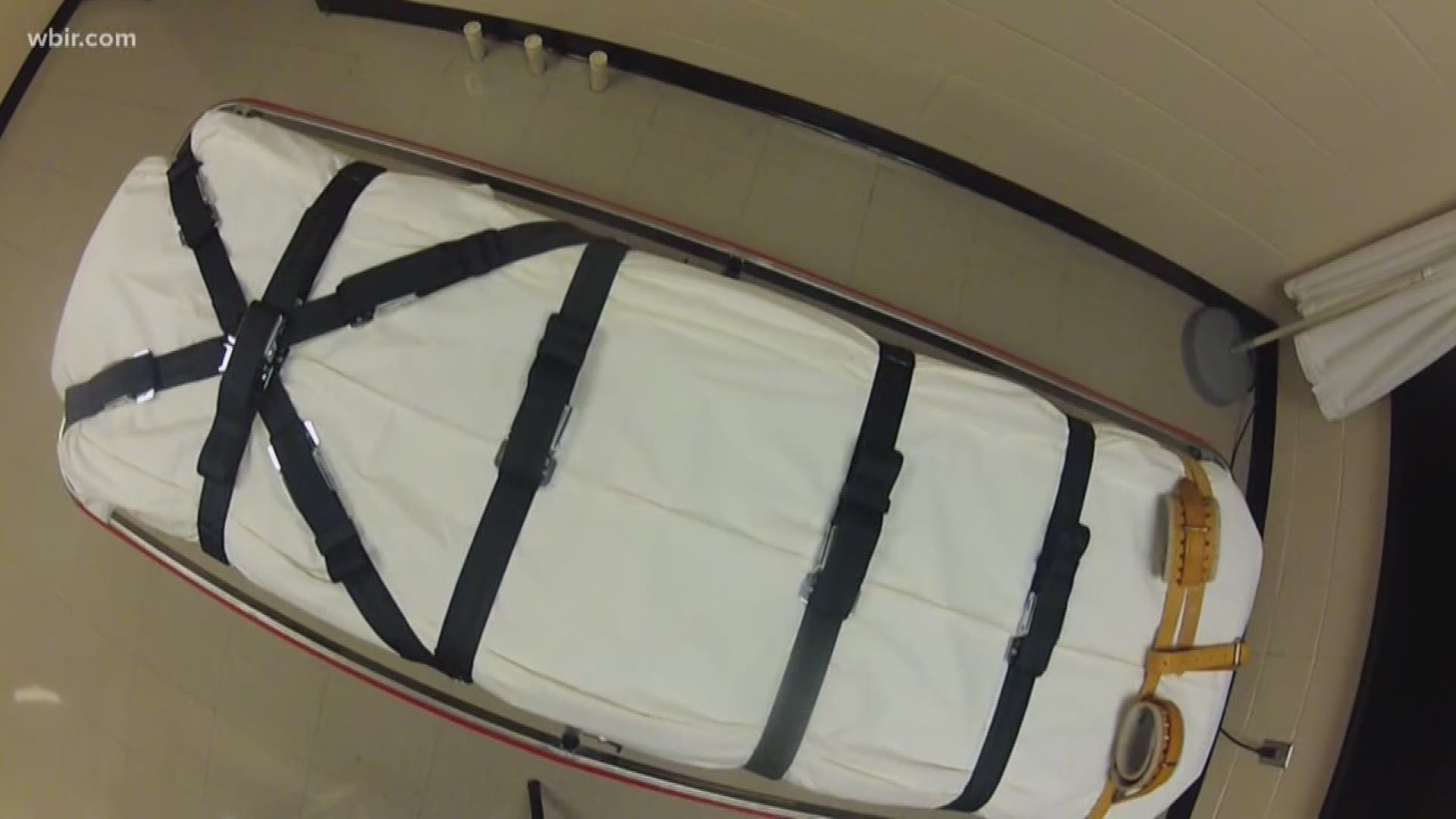Nashville — UPDATE FRIDAY: Attorneys for the state say Tennessee's Supreme Court shouldn't consider an expert's conclusions about "tortuous effects" of the latest execution in a challenge of the state's lethal injection protocol, the Associated Press reports.
The state's filing this week says the expert wasn't cross-examined and offered a medical opinion based on hearsay and media accounts.
In a previous filing for inmates challenging the protocol, Dr. David Lubarsky concluded based on media witness accounts that inmate Billy Ray Irick would've felt like he was choking. Lubarsky said Irick would've felt like he was drowning in his own fluids, suffocating, being buried alive and burning during his Aug. 9 execution.
Tennessee's response says inmates' attorneys want a retrial, which is outside of court rules and appellate jurisdiction. Oral arguments are slated for Oct. 3. The next execution is scheduled for Oct. 11.
PREVIOUS REPORT: Billy Ray Irick felt searing pain akin to torture before he died in a Tennessee prison in August, but steps taken in carrying out his execution blocked signs of suffering, according to a doctor who reviewed information about the lethal injection.
In new court filings entered late Thursday amidst an ongoing legal challenge of Tennessee’s lethal injection protocol, Dr. David Lubarsky said statements from people who witnessed the execution indicated the controversial drug midazolam failed to ensure Irick could not feel pain during his death.
RELATED: Witness to an execution
As a result, the death row inmate “experienced the feeling of choking, drowning in his own fluids, suffocating, being buried alive, and the burning sensation caused by the injection of the potassium chloride,” Lubarsky wrote in the filing.
The document also says the state did not follow its own lethal injection protocol, raising questions about whether executioners ever intended to ensure Irick was unable to feel the pain caused by the second and third lethal injection drugs.
REMEMBERING WHY: Rape and murder of 7-year-old Paula Dyer
Irick and 32 other death row inmates sued the state this year arguing that Tennessee’s new protocol for lethal injections would subject them to pain so intense it would violate the U.S. Constitution. They questioned the use of midazolam, the first of the three drugs the state administers during executions.
Lubarsky, a Florida doctor, testified for the inmates during a two-week trial in July. He said midazolam, which is supposed to render inmates unconscious and unable to feel pain, doesn’t work as intended. He said midazolam sedates inmates but does not stop them from feeling the effects of the other two drugs, vecuronium bromide and potassium chloride.
Lubarsky and other medical experts are the backbone for the inmate's appeal. The case is not about whether the death penalty is constitutional, attorneys for the death row offenders wrote in the 390-word brief. It's about what the deadly drugs do to a body, and whether Tennessee citizens should approve of that likely tortuous outcome.
"This case is about whether it is constitutional to inject a human with a small bottle of acid—which will destroy the lining of their lungs and cause them to drown in blood—and then to inject them with a paralytic that will leave them conscious but expressionless—unable to speak or scream—feeling as if they are buried alive, and finally to stop their heart with an injection that will, in their last minute of life, cause them to chemically burn alive," wrote Kelley Henry and other federal public defenders working on behalf of the death row inmates.
Davidson County Chancery Court Judge Ellen Hobbs Lyle agreed Lubarsky and other experts were well qualified, but she rejected their arguments in ruling against the inmates.
Lyle said whatever pain the inmates felt did not last long enough to count as unconstitutional torture, a stance blasted by U.S. Supreme Court Justice Sonya Sotomayor in an opinion issued hours before Irick's death.
The remaining death row offenders continue to pursue their appeal of Lyle's ruling even though no court stopped Irick's execution.
The Tennessee Department of Correction, represented by the Office of the Tennessee Attorney General, argued it is following the law and using drugs available to carry out the required punishment for death row offenders. Department officials noted during trial that the U.S. Supreme Court previously allowed executions using midazolam to proceed, arguing the usage is now case law.
In the latest filing though, Henry and the other attorneys argue that case law is not settled. They point to new and more expansive medical evidence, presented to Lyle during the trial, that has never been considered by the full Supreme Court.
They also blast the state's arguments in the new filing, writing: "Defendants’ repeated mantra, barely acceptable from a teenager, is that — 'all the other states are doing it, so it must be ok.'"
Executioners never prepared second dose of midazolam, records show
The protocol for how the state puts an inmate to death is very specific.
It requires the state prepare primary and back-up syringes for each of the drugs used in the lethal injection.
However, documents obtained by the inmates' attorneys show executioners did not prepare a back-up dose of midazolam. The report says executioners only prepared the one dose of midazolam used at 7:28 p.m., essentially the same time Irick's execution began.
The protocol requires the executioner to inject the midazolam into a tube that runs into the condemn's arm. After some time, the warden -- who is in the execution chamber -- is required to check to see if the condemned is conscious.
If the condemned is not conscious, the state protocol requires injecting a second dose of midazolam.
Riverbend Maximum Security Institute Warden Tony Mays conducted the consciousness check: he brushed Irick's eyelids, yelled his first name twice and appeared to grab his shoulder. If he had determined Irick was conscious though, it's unclear if the state could have or would have prepared another midazolam syringe.
"If Mr. Irick had responded to the consciousness assessment or there had been problems with the IV apparatus, the execution team would not have been prepared to carry out the contingency procedures in the manual," Henry and the attorneys write.
"Defendants’ failure to follow the procedures in the manual indicates that the protocol is meaningless for purposes of Defendants’ carrying out an execution and therefore creates a substantial risk of severe pain and suffering for Plaintiffs," the document says.
Taping Irick's hands hid signs of pain, expert says
Throughout his statement, Lubarsky said witness statements from Irick’s execution supported the inmates’ legal arguments. Lubarsky said he was convinced “to a reasonable degree of medical certainty” that Irick was not properly anesthetized during his execution. Any inmate not properly rendered unconscious and insensate would feel the “torturous effects of the lethal injection process,” Lubarsky said.
Witnesses described Irick choking, snoring, gulping and gasping for air as the drugs were administered. They also said he jolted and appeared to push against the restraints at one point.
Lubarsky noted that Irick’s hands were taped to the gurney during the execution. His fingers were wrapped with a tape-like substance that prevented movement and limited visibility of the majority of his hands.
Lubarksy said the tape blocked prison officials from seeing important signs that Irick was aware of his surroundings throughout the execution.
“A trained observer knows that if a patient moves his fingers or hands that is a clear indicator that that they are not anesthetized,” Lubarsky wrote. “The taping of Mr. Irick’s hands affirmatively prevented the Warden from observing an important indicator that Mr. Irick was not anesthetized.”
Tennessee courts denied all of Irick's legal requests, and appear poised to do the same ahead of the state's next execution.
The Tennessee Supreme Court recently evoked a rare legal move to set the schedule for the lethal injection challenge within the Court of Appeals. The schedule is condensed, leaving far less time for attorneys to prepare their case compared toa typical appeal.
State Supreme Court Justice Sharon Lee admonished her colleagues after they set the schedule, calling it a "rocket docket" that jeopardized inmates' chances for a fair trial.
In the new filing, attorneys ask the court to delay the appellate process.
Edmund Zagorksi, 63, is scheduled for execution on Oct. 11. He was convicted in 1984 of robbing and shooting John Dotson, of Hickman County, and Jimmy Porter, of Dickson, before slitting their throats, according to Tennessean archives.
Reach Adam Tamburin at atamburin@tennessean.com or 615-726-5986 and on Twitter @tamburintweets. Reach Dave Boucher at 615-259-8892, dboucher@tennessean.com and on Twitter @Dave_Boucher1.


